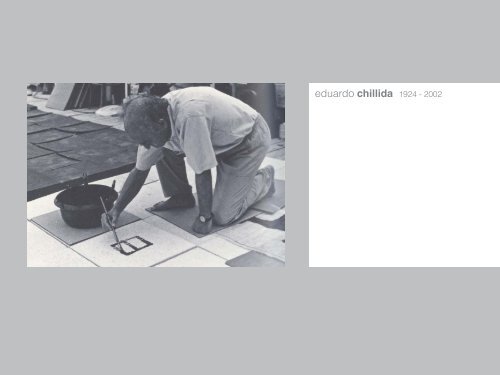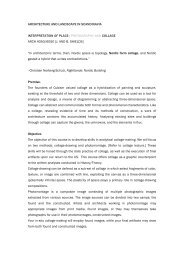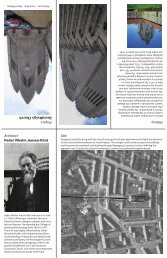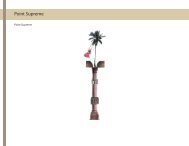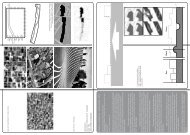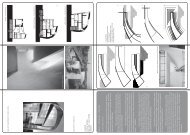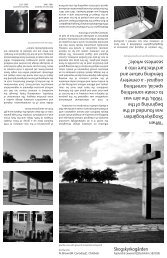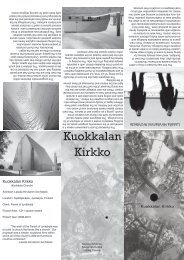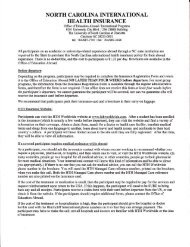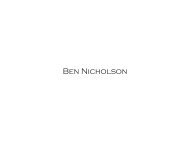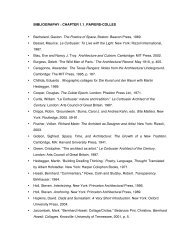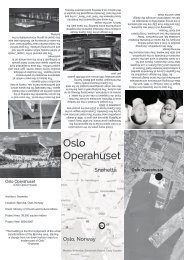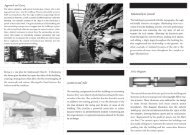eduardo chillida 1924 - 2002 - collage and architecture
eduardo chillida 1924 - 2002 - collage and architecture
eduardo chillida 1924 - 2002 - collage and architecture
Create successful ePaper yourself
Turn your PDF publications into a flip-book with our unique Google optimized e-Paper software.
<strong>eduardo</strong> <strong>chillida</strong> <strong>1924</strong> - <strong>2002</strong>
“I measure every day to<br />
know if I've grown,<br />
not to know my height.”<br />
<strong>1924</strong><br />
1936<br />
1943<br />
1947<br />
Eduardo Chillida Juantegui<br />
nace el 10 de enero en San<br />
Sebastian. Hijo de Pedro<br />
Chillida Aramburu, militar<br />
de carrera, y Carmen Juantegui<br />
Eguren, dedicada<br />
a la musica. Inicia sus estudios<br />
en el colegio de los<br />
marianistas.<br />
Es enviado en verano a<br />
casa del doctor Camus,<br />
amigo del la familia, en<br />
Paris, y luego a Melun,<br />
donde durante la guerra<br />
aprende frances.<br />
Comienza en Madrid la<br />
carrera de arquitectura.<br />
Fue portero de la Real<br />
Sociedad que dejo por una<br />
lesion en la rodilla.<br />
Ab<strong>and</strong>ona los estudios de<br />
arquitectura y pasa a dibujaren<br />
el Circulo de Bellas<br />
Artes de Madrid. Realiza<br />
sus primeras piezas de<br />
escultura.<br />
Eduardo Chillida was born<br />
January 10 in San Sebastian.<br />
Son of Pedro Aramburu<br />
Chillida, a career soldier,<br />
<strong>and</strong> Carmen Juantegui<br />
Eguren, dedicated to the<br />
music. He began his studies<br />
at the College of the<br />
Marianists.<br />
In the summer he is sent to<br />
the doctor Camus, a friend<br />
of the family in Paris, then<br />
to Melun, where he learned<br />
French during the war.<br />
The race begins in Madrid<br />
<strong>architecture</strong>. He was goalkeeper<br />
of the Royal Society<br />
only to leave because of a<br />
knee injury.<br />
Dropped out of <strong>architecture</strong><br />
<strong>and</strong> drawing at the Circulo<br />
de Bellas Artes in Madrid.<br />
Makes first pieces of sculpture.
1948<br />
1949<br />
1950<br />
1951<br />
Se traslada a Paris; alii coincide<br />
con Jose Guerrero,<br />
Eusebio Sempere y Pablo<br />
Palazuelo. Realiza sus<br />
primeras piezas en yeso,<br />
impresionado por Ia<br />
escultura griega arcaica<br />
del Louvre.<br />
La escultura Forma es<br />
presentada en el Salon de<br />
Mayo de Paris.<br />
Se casa con Pilar Belzunce<br />
en San Sebastian.<br />
Juntos se trasladan en<br />
octubre a Paris.<br />
Se exponen dos piezas en<br />
Ia exposicion Les Mains<br />
Eblouies, en Ia Galeria<br />
Maeght.<br />
En octubre regresan a<br />
Euskadi y se instalan en<br />
Hernani, donde se inicia<br />
en el hierro en Ia fragua<br />
de Manuel lllarramendi.<br />
Realiza Ia primera pieza<br />
en hierro, llarik.<br />
He moved to Paris; alii<br />
coincides with Jose Guerrero,<br />
Eusebio Sempere <strong>and</strong><br />
Paul Palazuelo. He makes<br />
his first pieces of plaster,<br />
impressed by the Greek<br />
sculpture of the Louvre.<br />
The sculpture Form is presented<br />
in the May Salon in<br />
Paris.<br />
He married Pilar Belzunce<br />
in San Sebastian. Together<br />
they moved to Paris in<br />
October.<br />
Two pieces are displayed<br />
at the Les Mains Eblouies<br />
exposition at Maeght<br />
Gallery.<br />
In October he returns <strong>and</strong><br />
settle in Hernani, which<br />
begins the iron forge<br />
works at Manuel lllarramendi.<br />
He makes the first<br />
piece of iron, llarik.
1952<br />
1954<br />
1955<br />
1956<br />
Realiza los primeros <strong>collage</strong>s.<br />
Sigue hacienda<br />
visitas frecuentes a Paris.<br />
Primera exposicion individual<br />
en Espana, en Ia<br />
Galeria Clan de Madrid.<br />
Realiza las cuatro puertas<br />
para Ia Basilica de<br />
Aranzazu.<br />
Diploma de Honor en Ia X<br />
Trienal de Milan.<br />
Realiza Hierros de temblor<br />
I, donde por primera vez<br />
corta Ia lamina de hierro:<br />
el corte como dibujo espacial<br />
que sera clave en<br />
Ia obra de los anos sesenta.<br />
Primera exposicion con<br />
27 esculturasen Ia Galeria<br />
Maeght de Paris. Gaston<br />
Bachelard (1884-1962)<br />
escribe en Derriere le<br />
miroir un ensayo, “Le cosmos<br />
du fer” sobre estas<br />
primeras piezas de hierro<br />
forjado.<br />
Makes first <strong>collage</strong>s. Keep<br />
making frequent visits to<br />
Paris.<br />
First solo exhibition in<br />
Spain at the Clan Gallery<br />
of Madrid. Makes the four<br />
doors to the Basilica of<br />
Aranzazu.<br />
Receives Diploma of<br />
Honor in the X Triennale<br />
Milan.<br />
Make Trembling I, where I<br />
first cut the sheet of iron:<br />
the cutting <strong>and</strong> drawing<br />
space that will be key to<br />
works of the sixties.<br />
First exhibition of 27<br />
sculptures at Maeght<br />
Gallery in Paris. Gaston<br />
Bachelard (1884-1962)<br />
writes in an essay Derriere<br />
Le Miroir, “Le cosmos du<br />
fer” on these first pieces of<br />
wrought iron.
1957<br />
1958<br />
1959<br />
1963<br />
Se trasladan de Hernani<br />
a San Sebastian. Manta el<br />
estudio, junto con Ia forja.<br />
Realiza lkaraundi dibuj<strong>and</strong>o<br />
en el espacio Ia vibracion<br />
de Ia linea. en plano.<br />
Recibe el Gran Premio lnternacional<br />
de Escultura de<br />
Ia XXIX Bienal de Venecia.<br />
Recibe el Graham Foundation<br />
Award for Advanced<br />
Studies in the Fine Arts.<br />
Primeras esculturas en<br />
madera: Abesti gogora<br />
I, en Ia actualidad en el<br />
Museum of Fine Arts de<br />
Houston. Participacion en<br />
Ia II Dokumenta de Kassel.<br />
Viaje a Grecia y a ltalia. Comienzo<br />
de su interes par Ia<br />
luz y Ia arquitectura, y par<br />
el concepto de limitar.<br />
He moves from Hernani<br />
to San Sebastian. Continues<br />
intense study <strong>and</strong> the<br />
forge.<br />
Makes lkaraundi drawing in<br />
space, the vibration of the<br />
line, flat.<br />
Awarded the Gr<strong>and</strong> Prize<br />
for Sculpture at Ia lnternational<br />
XXIX Venice Biennale.<br />
Receives Award for Advanced<br />
Studies in the<br />
Fine Arts from the Graham<br />
Foundation<br />
First sculptures in wood:<br />
Abesti Gogora I, at the<br />
present time in the Museum<br />
of Fine Arts in Houston.<br />
Participaties in Documenta<br />
II in Kassel.<br />
Travel to ltaly to Greece.<br />
Beginning of his interest<br />
in light <strong>and</strong> <strong>architecture</strong>,<br />
<strong>and</strong> even the concept of<br />
limiting.
1965<br />
1967<br />
1968<br />
1969<br />
Realiza en alabastro Homenaje<br />
a K<strong>and</strong>insky. Este<br />
material le proporciona una<br />
posibilidad de encuentro<br />
con Ia luz y Ia arquitectura.<br />
Aparecen los primeros<br />
escritos aforfsticos del escultor,<br />
titulados Aromas.<br />
Primer encuentro con el<br />
filsofo Martin Heidegger<br />
(1889-1976).<br />
Delante del nuevo edificio<br />
de Ia Unesco en Paris, se<br />
instala el Peine del viento<br />
IV.<br />
Realiza siete lito<strong>collage</strong>s<br />
para Die Kunst und der<br />
Raum de Martin Heidegger.<br />
Make alabaster Homage<br />
to K<strong>and</strong>insky. This material<br />
provides a chance encounter<br />
with light <strong>and</strong> <strong>architecture</strong>.<br />
the first writing artifacts by<br />
the sculptter appear, entitled<br />
Aromas.<br />
First encounter with the philosopher<br />
Martin Heidegger<br />
(1889-1976)<br />
Installs the Wind Comb IV.<br />
Before the new Unesco<br />
building in Paris.<br />
Make seven lito<strong>collage</strong>s<br />
to Die Kunst der Raum for<br />
Martin Heidegger.
1972<br />
1974<br />
1975<br />
1976<br />
En Ia ciudad de Lund, en<br />
Suecia, se inaugura Ia obra<br />
Campo espacio de paz.<br />
Realiza Lugar de encuentros<br />
Ill, hoy en el paseo de<br />
Ia Castellana, Madrid.<br />
Realiza una Estela para<br />
Giacometti. La escultura de<br />
acero Estela a Pablo Neruda<br />
se coloca en Teheran.<br />
Recibe el Premia Rembr<strong>and</strong>t<br />
de IaFundacin<br />
Goethe.<br />
Recibe el primer Premia<br />
del Ministerio de Asuntos<br />
Exteriores del Gobierno<br />
japones en Ia X Bienal de<br />
Grabado de Tokio, por el<br />
aguafuerte Euskadi IV.<br />
In the city of Lund in Sweden,<br />
openes the Campo<br />
area of peace work.<br />
Makes Meeting Place III,<br />
now in the Castellana,<br />
Madrid.<br />
Make a piece for the wake<br />
Giacometti. Steel sculpture<br />
of Pablo Neruda is placed<br />
in Teheran.<br />
Receives the Rembrant<br />
award from the Goethe<br />
Foundation.<br />
Awarded the first of the<br />
Ministry of Foreign Affairs<br />
of the Japanese government<br />
at the X Biennial of<br />
Engraving in Tokyo for the<br />
etching Euskadi IV.
1977<br />
1980<br />
1982<br />
1984<br />
Se comienza a instalar el<br />
Peinedel viento en San Sebastian.<br />
Empieza a trabajar<br />
Ia terracota en Saint Paul<br />
de Vence con Hans Spinner,<br />
en especial Ia tierra<br />
chamota.<br />
Obras realizadas en tierra,<br />
entre pan y ladrillo, con<br />
diferente tonalidad dependiendodel<br />
horno de lena o<br />
del horno electrico. Son las<br />
llamadas lurras.<br />
Exposicion en el Guggenheim<br />
Museum de Nueva<br />
York, con catalogo escrito<br />
par el poeta mexicano Octavia<br />
Paz. La exposicion<br />
pasa al Palacio de Cristal<br />
de Madrid y al Museo de<br />
Bellas Artes de Bilbao al<br />
ano siguiente.<br />
Realiza Ia Plaza de los fueros<br />
de Vitoria en colaboracion<br />
con el arquitecto Luis<br />
Pefia Ganchegui. Compra<br />
el caserfo Zabalaga<br />
en Hernani.<br />
Gran Prernio de las Artes<br />
en Francia, entregado<br />
por el ministro de Cultura<br />
Jacques Lang.<br />
Se empiezan a producir los<br />
dos filmes sobre el artista<br />
por parte de Jose Julian<br />
Baquedano y de Laurence<br />
Boulting.<br />
Begins to install the wind in<br />
San Sebastian . Start working<br />
on the terracotta Saint<br />
Paul de Vence with Hans<br />
Spinner.<br />
Works carried out on l<strong>and</strong>,<br />
between metallurgy <strong>and</strong><br />
brick, with different tone<br />
dependent on wood oven<br />
or electric oven. They are<br />
called LURRA.<br />
Exhibition at the Guggenheim<br />
Museum in New York,<br />
with written catalog by the<br />
the Mexican poet Octavio<br />
Paz. The exhibition moves<br />
to Crystal Palace in Madrid<br />
<strong>and</strong> the Museum of Fine<br />
Arts in Bilbao the following<br />
year.<br />
Carries out the Square of<br />
the Charters of Vitoria in<br />
collaboration with the architect<br />
Luis Pefia Ganchegui.<br />
Buy Zabalaga house in<br />
Hernani.<br />
Great Prernio of Arts in<br />
France, delivered by Minister<br />
of Culture Jacques<br />
Lang.<br />
They start to produce the<br />
two films about the artist by<br />
Jose Julian <strong>and</strong> Laurence<br />
Boulting Baquedano.
1989<br />
1990<br />
1992<br />
1994<br />
Es nombrado arquitecto<br />
honoraria por el Consejo<br />
Superior de los Colegios<br />
de Arquitectos de Espana.<br />
lnauguracion de Ia obra en<br />
acero De musica ante el<br />
Morton Meyerson Symphony<br />
Center del arquitecto<br />
leah Ming Pei, en Dallas.<br />
Se inaugura en Gijon el<br />
Elogio del horizonte. La<br />
Universidad de Verano del<br />
Pais Vasco le dedica un<br />
sirnposio. El Metropolitan<br />
Museum de Nueva York expone<br />
en su terraza Musica<br />
ca/lada II. Homenaje a<br />
Bach.<br />
Se inaugura, en el Muelle<br />
de Ia Sal de Sevilla, Monumento<br />
a Ia tolerancia.<br />
Primera exposicion del<br />
artista vasco en su ciudad<br />
natal.<br />
Es nornbrado miembro<br />
honoraria de Ia Real Academia<br />
de Bellas Artes de<br />
San Fern<strong>and</strong>o de Madrid.<br />
Is appinted Honorary architect<br />
by the Superior Council<br />
of Colleges of Architects<br />
of Spain.<br />
The lnauguracion of steel<br />
work in music at the Morton<br />
Meyerson Symphony Center<br />
with Ming Pei Architect<br />
in Dallas.<br />
Gijon opens in Praise the<br />
horizon. The Summer University<br />
of the Country<br />
Devotes a sirnposio<br />
Basque. The Metropolitan<br />
Museum of New York music<br />
out in the terrace<br />
ca / lada II. Homage to<br />
Bach.<br />
Opens the Monument of<br />
Tolerance at Muelle de Ia<br />
Sal de Sevilla.<br />
It is the Basque artist’s first<br />
exhibition in his hometown.<br />
Is named an honorary<br />
member Royal Academy of<br />
Fine Arts of San Fern<strong>and</strong>o<br />
in Madrid.
1995<br />
1997<br />
2000<br />
A finales de marzo recibe<br />
el Premia Libertad a Ia<br />
contribucion al humanismo<br />
de Ia Republica de Bosnia-<br />
Herzegovina, en Sarajevo.<br />
Es nombrado doctor honoris<br />
causa a propuesta de<br />
Ia Escuela de lngenieros<br />
Industriales de Ia Universidad<br />
del Pais Vasco.<br />
lnauguracion del Museo<br />
Chillida Leku en Hernani.<br />
Colocacion de Ia escultura<br />
Berlin ante Ia Cancillerfa<br />
alemana en Berlin.<br />
In late March receives the<br />
Freedom Award for his<br />
humanitarium contribution<br />
to the Republic of Bosnia-<br />
Herzegovina in Sarajevo<br />
Is awarded an Honorary<br />
doctorate from the Engineering<br />
School lngenieros<br />
at the Industrial University<br />
of the Basque Country.<br />
lnauguracion Chillida-Leku<br />
Museum in Hernani.<br />
Placement of a Ia Cancillerfa<br />
sculpture Berlin,<br />
Germany.
<strong>collage</strong>s<br />
1986<br />
1987<br />
Si bien a mediados de Ia decada de los ochenta, Eduardo Chillida parece rechazar y dejar de lado el <strong>collage</strong> al comenzar a<br />
realizar sus primeras Gravitaciones, de las cuales trataremos mas adelante, no ab<strong>and</strong>ona del todo esta tecnica que le permite<br />
seguir con sus interrogaciones al espacio. Entre los cinco <strong>collage</strong>s presentes en Ia muestra podemos establecer una clara diferenciacion.<br />
Por un Ia do, destaca un <strong>collage</strong> caracterizado por Ia ausencia de tinta y Ia presencia de diferentes tipos de papel,<br />
y por otro, cuatro <strong>collage</strong>s mas proximos a los dibujos debido a Ia incorporacion de trazos negros de tinta sabre el papel. Sin<br />
embargo, todos ellos tienen un tema comun, Ia delimitacion de espacios. Ese primer <strong>collage</strong>, fechado en 1986, esta compuesto<br />
por diferentes tipos de papel recortados encolados en el plano que, superpuestos, generan un dialogo entre las formas.<br />
1991<br />
1992<br />
During the mid-eighties, Eduardo Chillida seems to reject <strong>and</strong> ignore the <strong>collage</strong> to start making their first gravitational, of which<br />
we will see later, not completely ab<strong>and</strong>oned this technique that allows you to continue with their interrogation of space. Among<br />
the five <strong>collage</strong>s present in the sample we can establish a clear differentiation. For a Ia do, features a <strong>collage</strong> characterized by<br />
the absence of ink <strong>and</strong> the presence of different types of paper, <strong>and</strong> on the other, four <strong>collage</strong>s closer to the drawings because<br />
incorporacion of black sabre ink on paper. However, they all have a common theme, Ithe delimitation of spaces. That first <strong>collage</strong>,<br />
dated 1986, is composed of different types of cut paper glued on the plane, overlapping, create a dialogue between the<br />
shapes.<br />
Sin titulo, 1986 Sin titulo, 1987 Sin titulo, 1991 Sin titulo, 1992
“The limit is the true protagonist of space at present,<br />
another limit, is the true protagonist of time”<br />
1992<br />
No precisa de Ia incorporacion de tinta porque los bardes del papel son los propios limites, marcan los diferentes espacios.<br />
Los diferentes contornos interrelacionan entre si facilit<strong>and</strong>o un juego de formas. El artista juega con las diferentes texturas, de<br />
apariencia rugosa, y con Ia creacion de formas sencillas y puras. Se trata de un <strong>collage</strong> mas proximo al concepto escultorico<br />
que al dibujo bidimensional. En el resto de <strong>collage</strong>s, mas cercanos a sus dibujos, los trazos de tinta dialogan con los bordes recortados<br />
consiguiendo asi un interesante juego de limites. Si al principia de su carrera artistica tuvo que comenzar a dibujar con<br />
Ia mano izquierda para que esta no fuera mas rapido que su mente, en las ultimas decadas las manos parecen haber adquirido<br />
Ia sabiduria necesaria para no adelantarse a su cabeza. Las lineas son trazadas conclenzudamente, con lentitud, no surgen de<br />
forma espontanea como cabria imaginar, ya no tiene que controlar Ia mano pues a mente Ia ha adiestrado.<br />
It does not require the incorporation of ink because the edges of the paper are those limits, mark the different spaces. The different<br />
contours interrelated with each providing a set of forms. The artist plays with different textures, rough appearance, <strong>and</strong><br />
the creating simple <strong>and</strong> pure forms. This is a <strong>collage</strong> sculptural closer to the concept than two-dimensional drawing. In the rest<br />
of <strong>collage</strong>s, closest to his drawings, ink strokes dialogue with jagged edges so getting an interesting set of limits. If at the beginning<br />
of his artistic career he had to start drawing with left h<strong>and</strong> so that it is not faster than your mind, in recent decades he seems<br />
to have acquired h<strong>and</strong>s of wisdom that do not get ahead of his head. The lines are drawn consciencelessly, slowly, do not arise<br />
spontaneously as one would imagine, <strong>and</strong> not have the h<strong>and</strong> controlling the mind has we have been trained.<br />
Sin titulo, 1992
gravitiaions<br />
1987<br />
1989<br />
A traves de las gravitaciones se genera en su proceso creativo una nueva via de experimentacion. En este periodo, marcado<br />
por Ia importancia de Ia obra publica en su produccion, al contrario de estos monumentos a gran escala, Chillida abre un nuevo<br />
camino expresivo en Ia intimidad de su estudio, un proceso creative original: las gravitaciones. Realizadas en papeles artesanales<br />
elaborados a mano, las gravitaciones se alejan del concepto plastico de <strong>collage</strong>. Eduardo Chillida, ciertamente cansado de<br />
Ia utilizacion de Ia cola que no deja pasar el espacio en sus creaciones, descubre una nueva forma de actuacion; donde antes<br />
habia cola ahora “mete” el espacio. Asi, en 1985, realiza su primera Gravitacion: “Nacen inesperadamente. Un dia est<strong>and</strong>o<br />
yo trabaj<strong>and</strong>o como cualquier otro dia. A mi nunca me habia gustado Ia cola. El hecho de pegar los papeles no me parecia el<br />
ideal, pero nunca se me habia ocurrido que se podia solucionar de muchas maneras.<br />
1990<br />
1990<br />
Through the gravitational generated in the creative process a new way of experimentation. During this period, marked by Ia Ia<br />
importance of public works in their production, in contrast to these large-scale monuments, Chillida opens new Ia expressive intimacy<br />
of his studio, original creative process: the gravitational. Made of h<strong>and</strong> made paper, the gravitational plastic away from the<br />
concept of <strong>collage</strong>. Eduardo Chillida, certainly tired of Ia utilization of the tail does not pass the space in their creations, discover<br />
a new way of working, where before had tail now “gets” space. Thus, in 1985, made his first Gravitation, “born unexpectedly.<br />
One day while I was working like any other day. As I never had liked the tail. The fact I did not hit the papers seemed ideal, but I<br />
never had happened that could be solved in many ways.<br />
Gravitation, 1987<br />
Gravitation, 1989<br />
Gravitation, 1990<br />
Gravitation, 1990
1991<br />
1991<br />
1991<br />
1993<br />
De repente pense: Por que en vez de pegar estos dos papeles con cola no los unes de alguna manera, los coses con cuerda<br />
o con lo que sea Empece a darle vueltas, a hacer pruebas, y claro, inmediatamente. Adem as, me di cuenta de las consecuencias<br />
que tenia. En ellugar donde antes estaba Ia cola metias el espacio. Como vas a comparar el espacio con Ia cola!”<br />
Ellenguaje utilizado en estas piezas en papel es el mismo que en Ia escultura o en el dibujo, pero en esta epoca las formas son<br />
mas depuradas, caracterizadas por Ia simplicidad y Ia eliminacion sistematica de elementos retoricos, lo cual se materializa en<br />
formas sencillas pero de gran fuerza expresiva. Las gravitaciones le conducen hacia el camino de Ia ingravidez. AI contrario del<br />
uso de materiales pesados como el hormigon y el acero para rebelarse contra el peso, estos relieves de papel transmiten por sf<br />
mismos sensacion de ligereza y livi<strong>and</strong>ad.<br />
Suddenly I thought: Why instead of hitting these two roles with glue not join in any way, sew with rope or whatever I started to<br />
spin, to make tests, <strong>and</strong> of course, immediately. In addition as I realized the impact he had. In ellugar where the tail was previously<br />
put the space. As you compare the space with the tail! "Ellenguaje used in these pieces on paper is the same as in Ia<br />
sculpture or drawing, but in this time are more refined forms, characterized by the simplicity <strong>and</strong> the elimination of elements<br />
systematically rhetoric, which is embodied in a simple but highly expressive. The gravitational lead you towards the path of Ia<br />
weightlessness. Instead of using AI heavy materials such as concrete <strong>and</strong> steel to rebel against the peso, these reliefs of paper<br />
transmitted by sf same feeling of lightness <strong>and</strong> levity.<br />
Gravitation, 1991 Gravitation, 1991 Tribute to Bach, 1991<br />
Gravitation, 1993
“Light upon light snow<br />
White on white<br />
Is the light of the mind<br />
First light of Greece”<br />
1993<br />
1994<br />
1997<br />
Gravitation, 1993<br />
Gravitation, 1994<br />
Deep is the Air, 1997


